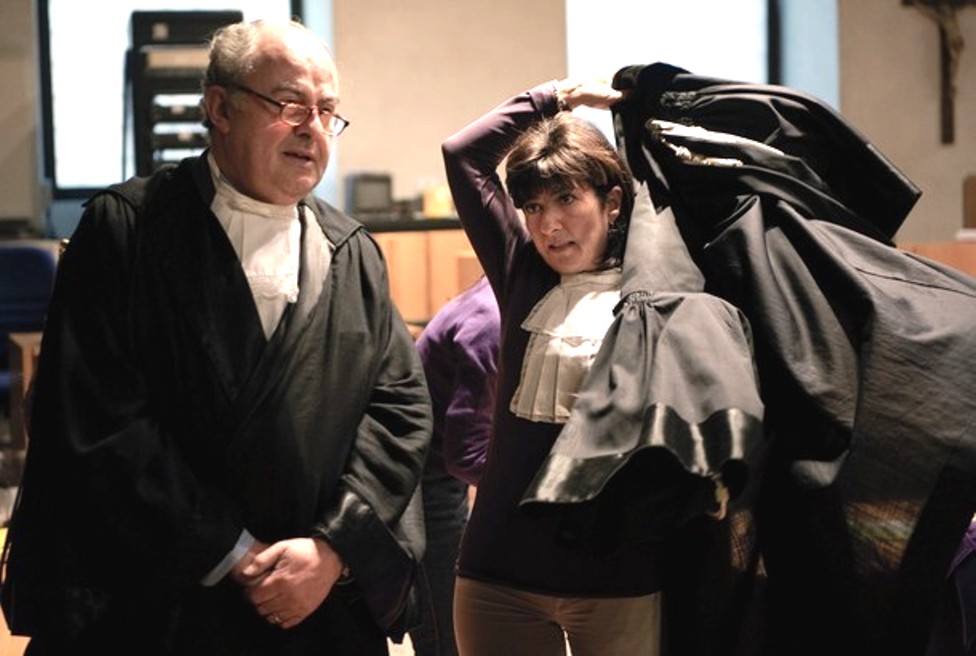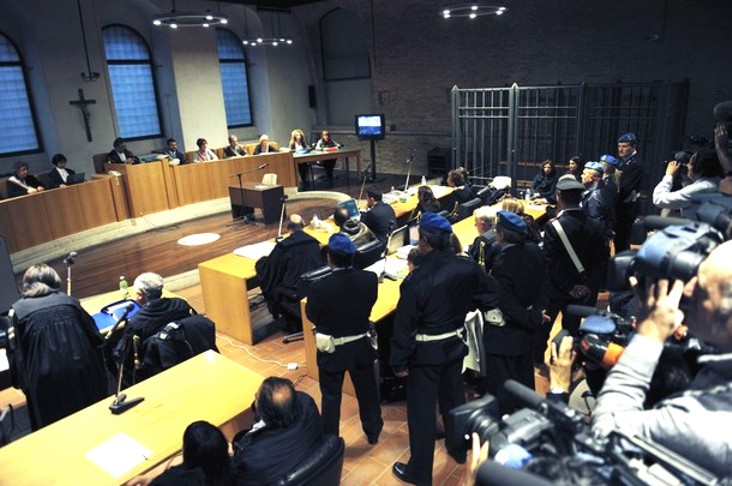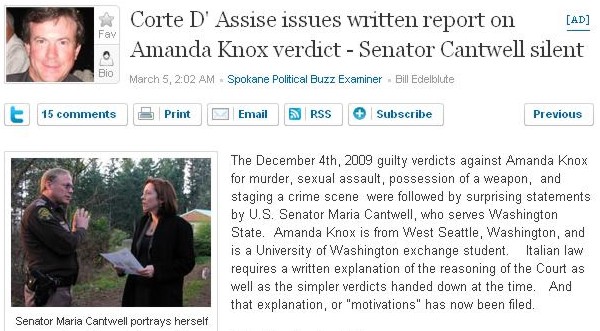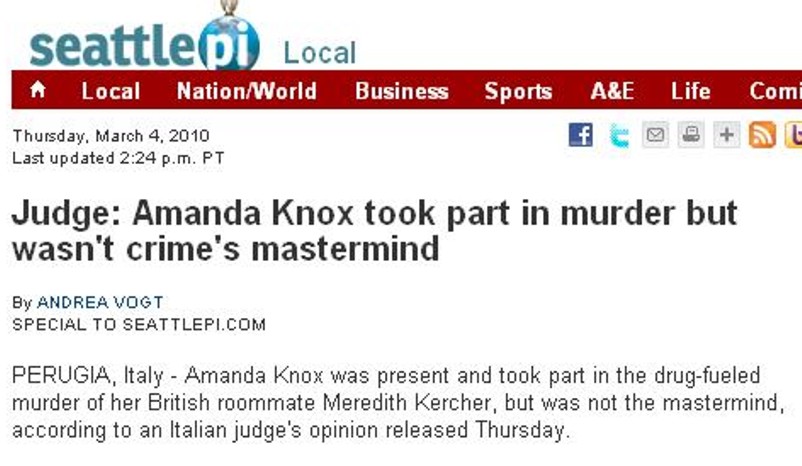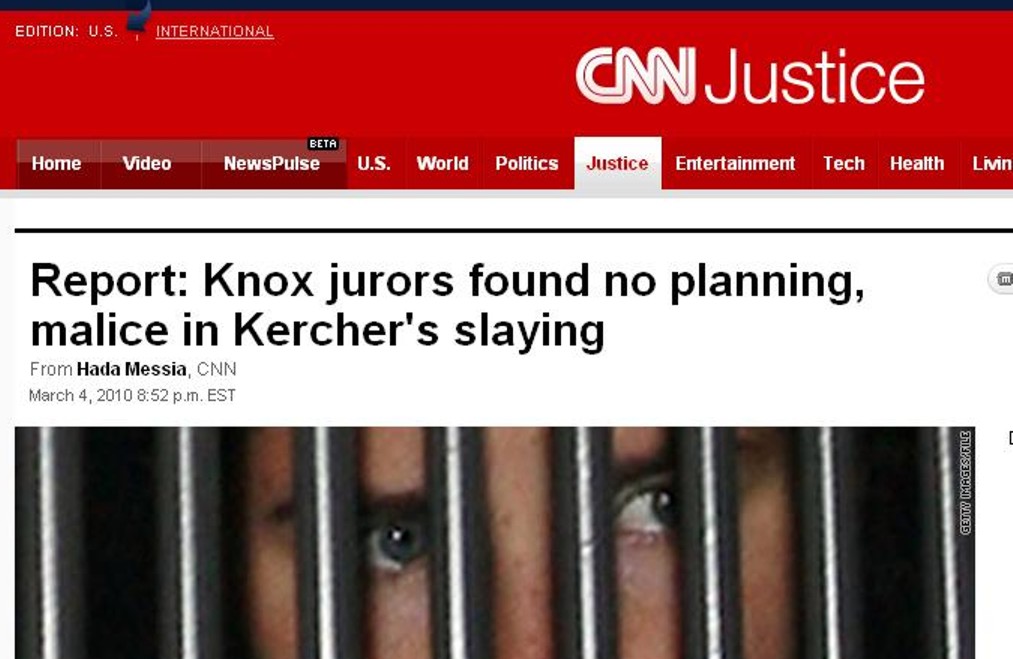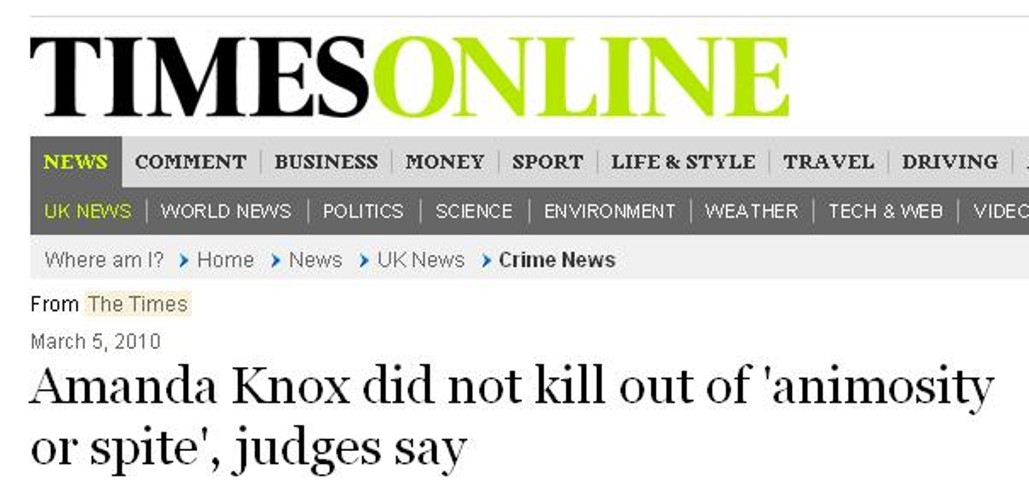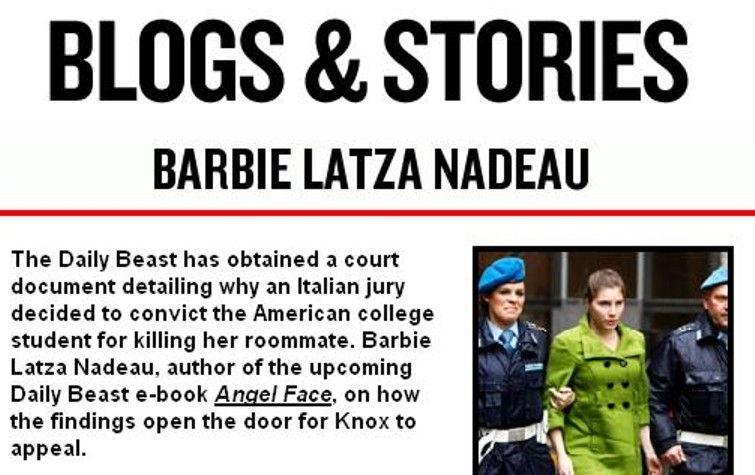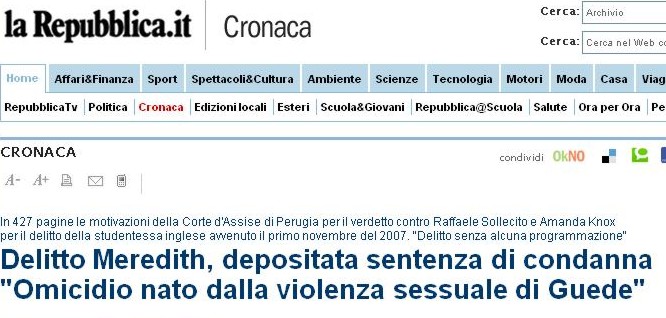
Category: The Massei Report
Monday, September 20, 2010
Explaining The Massei Report: All Judges, Lawyers And Witnesses At Trial Jan-Dec 2009
Posted by Storm Roberts
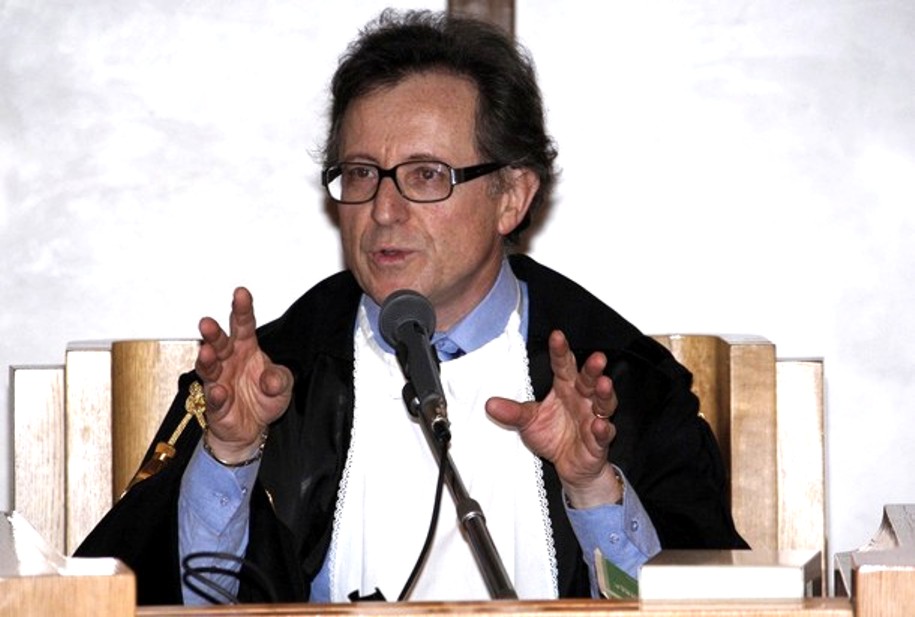
[Above: Dr Giancarlo Massei, the president of the Court]
Our intention with this new series of posts is to show how thorough the trial was, and how compelling the Massei Report on the grounds for the Knox-Sollecito sentence is.
At the beginning of the trial, the witness counts were considerable: approximately 90 for the prosecution, 60 for the civil plaintiffs, 90 for the defence of Raffaele Sollecito, and 65 for the defence of Amanda Knox.
However, a large number of witnesses for both Amanda Knox and for Raffaele Sollecito were removed from the witness listing. Thus the actual number of people testifying was lower than originally expected.
Here is a comprehensive list I have compiled, made by going through the Massei Report, picking out the witnesses, and noting what they testified about. If I had the information available, I have noted where a witness was specifically called by the defence of either of the then defendants.
Officers Of The Court
- Judges: Dr Beatrice Cristiani and Dr Giancarlo Massei, the president of the Court.
- Prosecutors: Public Ministers Dr Manuela Comodi and Dr Giuliano Mignini.
- Interpreter for Amanda Knox: Dr Anna Baldelli Fronticelli.
The Legal Teams:
- For the family of Meredith Kercher: Francesco Maresca and Serena Perna.
- For Diya “Patrick” Lumumba: Carlo Pacelli.
- For Aldalia Tattanelli (the owner of the house): Letizia Magnini.
- For Amanda Knox: Luciano Ghirga and Carlo Dalla Vedova.
- For Raffaele Sollecito: Giulia Bongiorno, Daniela Rocchi and Luca Maori.
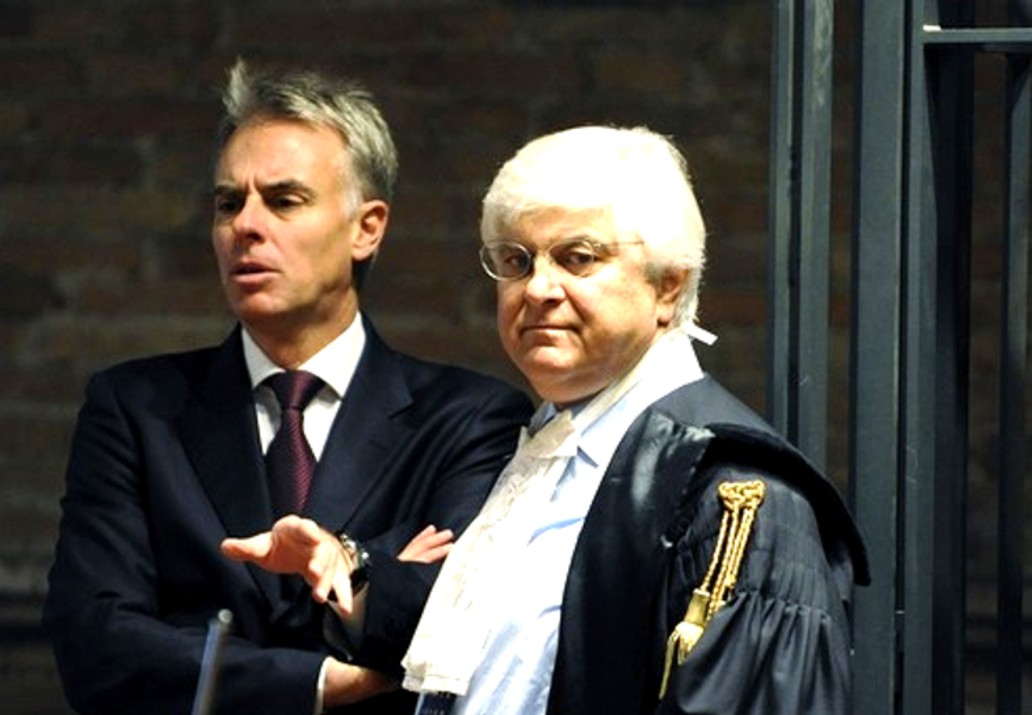
[above: Amanda Knox’s legal team]
Witnesses
The following is a list of witnesses and a brief note as to the evidence they presented. I am not detailing their arguments here, merely indicating the areas the witnesses were heard in. For full details of the evidence and the court’s arguments please read the Massei Report in full and the summaries coming up.
- Amanda Knoxtestified while not under oath at the request of her defence and the legal team representing Diya Lumumba. Her testimony was heard on 12th and 13th June 2009. Raffele Sollecito made a couple of interventions from his seat beside his three lawyers, but he did not get up on the stand.
- Mrs. Elisabetta Lana and her son, Alessandro Biscarini. They discovered two mobile phones, both belonging to Meredith Kercher (one was registered to Filomena Romanelli, Meredith’s flatmate), in their garden at Via Sperandio.
- Dr. Filippo Bartolozzi - at the time Manager of the Department of Communications Police for Umbria - Dr. Bartolozzi received the mobile phones from Mrs Lana, the first at approximately 11.45 to 12.00hrs on 2nd November 2007, the second at approximately 12.15 to 12.20 hrs. He traced the first phone to Filomena Romanelli and, at noon, despatched two officers to her address to investigate why her phone was in Mrs. Lana’s garden.
- Inspector Michele Battistelli and Assistant Fabio Marzi - the two officers despatched by Dr. Bartolozzi. They arrived at 7 Via della Pergola at a little after 12.30 hrs - they found Amanda Knox and Raffaele Sollecito sitting outside the house. They gave evidence about the circumstances leading up to the discovery of Meredith’s body and with regards to securing the scene whilst awaiting the Carabinieri and Scientific Police.
- Filomena Romanelli who was Meredith’s flatmate gave evidence regarding the phone she had lent to Meredith. She also detailed when she had moved into the flat at 7 Via della Pergola and the living arrangements. She told of her plans for the 2nd November and how a worrying phone call from Amanda Knox led to her calling her back and returning to her home earlier than planned. A key point of Ms. Romanelli’s evidence was her disagreement with Amanda Knox over when Meredith locked her door - Ms. Romanelli stated that Meredith had only once locked her door and that was when she had returned to England for a few days.
- Paola Grande, Marco Zaroli and Luca Altieri - the other young people who were at the property when Meredith’s body was discovered. Mr. Altieri broke down the door to Meredith’s room.
- Laura Mezzetti - the fourth flatmate in the upstairs flat at number 7 Via della Pergola. She testified with regards to the living arrangements and also that Amanda Knox is an early riser, a “morning person”.
- Robyn Butterworth, Amy Frost, Sophie Purton and Nathalie Hayward - Meredith’s friends from England. They testified as to when they last saw Meredith and described the behaviour of Amanda Knox and Raffaele Sollecito at the Police Station in the evening of 2nd November 2007. They also testified that Meredith had no plans after returning home at around 21.00 hrs on 1st November other than to study and have a rest as they had been out late the previous night and believed that they had classes the next day. Meredith’s friends did not know of Rudy Guede and had not heard Meredith mention his name.
- Giacomo Silenzi, one of the young men living in the flat underneath Meredith’s flat. He was Meredith’s boyfriend.
- Stafano Bonassi, Marco Marzan and Riccardo Luciani the other tenants of the downstairs flat. Along with Mr. Silenzi they testified as to the the interactions between themselves and the girls upstairs, the gatherings they held, the fact that Rudy Guede was known to Amanda Knox. They testified as to Rudy Guede’s actions at their house. They gave evidence of having met or known of Raffaele Sollecito and his relationship with Amanda Knox.
- Giorgio Cocciaretto a friend of the young men in the downstairs flat testified with regards to knowing Rudy Guede through playing basketball and having seen him at the 7 Via della Pergola house when both Meredith and Amanda Knox were present.
- Rudy Guede availed himself of his right not to participate in the trial of Amanda Knox and Rafaelle Sollecito. Judge Massei details Rudy Guede’s involvement based upon the evidence available in order to complete the reconstruction of events of 2nd November as he was charged alongside Amanda Knox and Raffaele Sollecito.
- Marta Fernandez Nieto and Caroline Espinilla Martin - two young ladies living in the flat above Rudy Guede, they testified than on the night of 31st October they had been in the presence of Rudy Guede and that the only girl they saw him dance with was a “blonde girl with long smooth hair”.
- Gioia Brocci from the Questura of Perugia who testified with regards to a trail of shoe prints leading from Meredith’s room to the exit of the flat getting fainter as they went. Ms. Brocci also testified as to the lack of signs of climbing on the wall below Filomena Romanelli’s window. She also collected evidence from the bathroom next to Meredith’s room.
- Sergeant Francesco Pasquale testified as to the possibility of breaking into the flat though the window in Filomena Romanelli’s room. Sergeant Pasquale was a consultant for the defence.
- Maria Antonietta Salvadori Del Prato Titone, Paolo Brocchi, Matteo Palazzoli and Cristian Tramontano testified with regards to previous incidents involving or possibly involving Rudy Guede.
- Edda Mellas , Amanda Knox’s mother. She testified as to communications with her daughter on the 2nd November amongst other things.
- Antonella Negri a teacher at the University who taught Amanda Knox and who testified as to her diligence as a student.
- Francesco Sollecito, father of Raffaele Sollecito. He testified as to his son’s character and about his communications with his son. He also spoke of his son’s relationship with Amanda Knox.
- Antonio Galizia, Carabinieri station commander in Giovinazzo, the Sollecito family’s home town. He testified that in September 2003 Raffaele Sollecito was found in possession of hashish.
- Jovana Popovic testified as to the presence of Amanda Knox at Raffaele Sollecito’s home at two points in time on the evening of 1st November 2007.
- Diya “Patrick” Lumumba was Amanda Knox’s employer at “Chic”. He testified that he has sent her a text message excusing her from work on the evening of 1st November.
- Rita Ficcara Chief Inspector of the State Police - to whom Amanda Knox delivered a written statement composed whilst she was awaiting to be transferred to Capanne Prison.
- Antonio Curatolo - Mr. Curatolo testified as to having seen Amanda Knox and Raffaele Sollecito at the basketball court in front of the University (the Piazza Grimana) in the evening of 1st November 2007.
- Maurizio Rosignoli - who runs a kiosk in the Piazza - testified with regards to the timing of buses at the Piazza Grimana thus corroborating times in Mr. Curatolo’s evidence.
- Alessia Ceccarelli - who worked managing Mr. Rosignoli’s kiosk - gave evidence as to Mr. Curatolo’s presence in the Piazza.
- Marco Quintavalle, who runs the shop “Margherita Conad”, testified he had seen Amanda Knox at 07.45 hrs on 2nd November, she was waiting for him to open his shop, she went to the section of the store that had items such as groceries, toilet paper and cleaning products but he did not serve her at the till so could not specify what she bought if anything. He testified that he knew Raffaele Sollecito as he was a regular customer.
- Officer Daniele Ceppitelli gave evidence with regards to the 112 calls made by Raffaele Sollecito at 12.51 and 12.54 hrs on 2nd November. In these calls Raffaele Sollecito declared that nothing had been stolen from the flat.
- Nara Capezzali, Antonella Monacchia and Maria Ilaria Dramis gave evidence of unusual sounds and activity coming from the area around 7 Via della Pergola - namely a scream and the sound of running footsteps.

[one of Sollecito’s three lawyers with Sollecito]
Expert Witnesses
- Dr. Lalli, the Coroner, he performed the post mortem and ascertained the cause of death and a “time window” when death was likely to have occurred. He put the time of death between 20.00 hrs on 1st November 2007 and 04.00 hrs the following day.
- Dr. Domenico Giacinto Profazio was head of the Perugia Flying Squad at the time of Meredith’s death. He gave evidence regarding the investigative procedures and safeguards including the physical security of the property.
- Dr. Marco Chiacchiera, deputy director of the Perugia Flying Squad also gave evidence regarding the scene and investigation.
- Monica Napoleoni, Deputy Commissioner of the State Police gave evidence regarding the scene and investigation. She also testified as to Raffaele Sollecito’s desire to remain with Amanda Knox.
- Mauri Bigini a chief inspect at the Flying Squad confirmed the evidence given by Profazio and Napoleoni.
- Armando Finzi a chief inspector at the Flying Squad gave evidence regarding the examination of Raffaele Sollecito’s flat and the collection of the knife which is now termed “the Double DNA Knife” (Exhibit 36).
- Stefano Gubbiotti and Zugarini Lorena confirmed the evidence regarding the search of Raffaele Sollecito’s flat.
- Dr. Giunta from the Scientific Police in Rome directed the detection of latent prints at the scene.
- Dr. Patrizia Stefanoni from the Scientific Police in Rome collected biological trace evidence for analysis. She also performed the analysis of DNA evidence and testified extensively on all aspects of DNA - from the background science, through the collection and the testing methods employed to the analysis.
- Professor Mauro Marchionni, Dr. Vincenza Liviero and Professor Mauro Bacci, the three consultants appointed by the Public Ministers to analyse the forensic medical evidence testified as to various aspects of Dr. Lalli’s report including the cause of death, timing of death, the sexual assault and the wounds. They reported on the degree of compatibility of the knife - Double DNA Knife, Exhibit 36 - with the wounds suffered.
- Professor Gianaristide Norelli, the consultant for the civil party, is a forensic police doctor. He testified with regards to the time and cause of death and the sexual assault against Meredith. He testified as to the degree of compatibility of the Double DNA Knife with the wounds suffered.
- Professor Francesco Introna, a consultant appointed by Raffaele Sollecito’s defence testified with regards to the forensic medical evidence (cause and time of death, the sexual assault). His opinion is that the murder was committed by one person and that the Double DNA Knife was not the weapon used to inflict the large wound on the left of Meredith’s neck. He hypothesised that Meredith was already undressing at the end of the day when she was surprised by her sole attacker who attacked from behind.
- Professor Carlo Torre, a consultant appointed by Amanda Knox’s defence testified with regards to the same areas as described above. In his opinion the Double DNA knife was not the knife used to inflict the large wound on the left of Meredith’s neck. He believed a stabbing from the front was the most likely dynamic, and he saw nothing that would lead him to believe there was more than one attacker.
- Professor Vinci, a consultant appointed by Raffaele Sollecito’s defence, he testified with regards to the stains on the bed sheet -which appeared to be made in blood, outlining a knife. Professor Vinci also testified with regards to footprints found in the flat.
- Dr Patumi, a consultant appointed by the defence of Amanda Knox, testified with regards to the neck wounds suffered and also with regards to the genetic evidence as detailed by Dr. Stefanoni.
- Professor Anna Aprile, Professor Mario Cingolani and Professor Giancarlo Umani Ronchi, all independent consultants appointed by the judge (GIP) at the preliminary hearing. Professor Aprile testified specifically on the question of the sexual assault, Professors Cingolani and Umani Ronchi again considered the evidence with regards to the cause and time of death and the compatibility of the Double DNA Knife with the large wound on the left of Meredith’s neck.
- Dr. Torricelli, the consultant for Meredith Kercher’s family, testified and gave her opinion on the genetic evidence as detailed by Dr. Stefanoni.
- Dr. Sarah Gino, a consultant appointed by the defence of Amanda Knox, testified and gave her opinion on the genetic evidence as detailed by Dr. Stefanoni.
- Professor Tagliabracci, a consultant appointed by Raffaele Sollecito’s defence, testified and gave his opinion on the genetic evidence as detailed by Dr. Stefanoni. He also gave evidence with regards to the effects of certain drugs.
- Marco Trotta, Claudio Trifici and Gregori Mirco officers of the Postal Police, gave evidence with regards to the seized computer equipment and also with regards to internet activity at the home of Raffaele Sollecito.
- Mr. Fabio Formenti, the technical consultant appointed by Raffaele Sollecito’s defence - observed the Postal Police’s analysis of the computer equipment.
- Dr Michele Gigli and Dr. Antonio D’Ambrosio, consultants appointed by Raffaele Sollecito’s defence, testified with regards to the computer and internet evidence.
- Chief Inspector Letterio Latella gave evidence with regards to mobile phones and how they pick up signals from base stations which cover certain areas, he also testified with regards to the call records of the mobile phones of the defendants, victim and others. He detailed how a connection to the network was picked up by the base stations and how the location of the phone can be approximated through knowing which base station was used. He was able to tell the court which connections to Meredith’s two phones were made from her own flat and which from Mrs. Lana’s garden.
- Assistant Stefano Sisani provided evidence with regards to both landline telephone services and mobile phone services.
- Bruno Pellero an engineer appointed by Raffaele Sollecito’s defence to give evidence with regards to telephonic communications.
- Dr. Lorenzo Rinaldi, Principal Technical Director of the State Police, director of the three sections which compose the Identity Division of the ERT, gave evidence regarding shoe prints and footprints (including those highlighted by the use of luminol.
- Chief Inspector Pietro Boemia, who worked alongside Dr. Rinaldi.
- Chief Inspector Claudio Ippolito a consultant who reported on shoe prints - appointed by the public minister.

[Background: the Judges and jury (lay judges) for the trial]>
Saturday, September 18, 2010
Explaining The Massei Report: Its Reasons For Existence And Its Significance In The Appeals
Posted by Storm Roberts
Inroduction
What is the “Massei Report”? Put simply, the Massei Report is a document produced by the two professional judges, Dr. Beatrice Cristiani and Dr. Giancarlo Massei, who presided over the trial of Amanda Knox and Raffaele Sollecito at the Court of Assize in Perugia from 16th January to 5th December 2009, which explains the judgement and sentencing.
In reality this document is far more than that. It examines the evidence laid before the court; it discusses both the prosecution and defence cases in great detail - referring back to both the documented evidence produced to the court and to witness testimony; it explains who the witnesses are, it evaluates their reliability and precisely what their evidence tells the court; it gives a detailed analysis of how the court came to it’s verdict. This document is a careful and considered analysis of the entire trial, from opening procedural arguments through to the final sentencing.
The most important aspect of this report is that, despite the need to be cool, dispassionate, focussed on evidence and cold, hard fact, at no point do the authors loose sight of the fact that this report is about a human being: Meredith Kercher.
The Massei Report comes at the end of the initial trial of Amanda Knox and Raffaele Sollecito for the murder of Meredith Kercher (and other charges - see below). It is not however the end of the judicial process. The Italian system gives two appeals to those convicted at their first trial.
The first appeal can be an appeal from the defence, the prosecution, or both, and is a review of the merit of the decision of the first trial and is heard by different judges and lay judges - it is not a full review of the evidence, it is a review of the merit of the decision of the first trial and is heard by different judges and lay judges.
The second and final appeal is to the Italian Supreme Court and is on matters of errors in procedure or in the application of the law, it is not a review of the evidence. The appeals process is described by Commissario Montalbano here on TJMK (link to post of 17th August 2010)
The Massei Report is the basis of the appeal, to be heard later this year, by both the prosecution and the defence teams of Amanda Knox and Raffaele Sollecito. Both defence teams have submitted their appeals and they will be heard in due course. I note, for the sake of clarity, that, it is the job of the defence teams to question the Massei Report - simply because the defence teams have questioned the report does not, at this stage, mean that the Massei Report is incorrect. As of today, prior to the appeal court’s judgement, the Massei Report is the definitive discussion of the case against Amanda Knox and Raffaele Sollecito and the judgement passed against them.
For those who wish to have a detailed knowledge of evidence presented in the case against Amanda Knox and Raffaele Sollecito there is no substitute for reading the Massei Report in it’s entirety - it is available, thanks to the work of a dedicated team of volunteers, both here on TJMK and on the PMF forum, in English (Please see the link in the menu on the left of your screen). Here I am going to highlight some areas considered in the report, my hope being that, in highlighting certain evidence, it will be possible to address the areas most often called into question by those who do not have full information on this sad case. This is not a full review of the Massei Report.
Even for those who have followed this case the Massei Report has some surprises. For example, I knew that both the prosecution and defence teams had appointed experts in forensic medicine and science, but I had not realised that, at an earlier hearing the Perugian court had appointed it’s own forensic experts, thus there were three sets of experts heard at the trial - the prosecution’s, the defences’, and independent court appointed experts.
N.B. In the following review the references to page numbers relate to the above mentioned translation of the Massei Report - specifically the first published version - v1.0 - dated 8th August 2010.
The charges. [Pages 10-13]
Amanda Knox and Raffaele Sollecito were charged, alongside Rudy Guede, with the murder of Meredith Kercher at the flat Amanda Knox shared with Meredith and two Italian girls at number 7 Via della Pergola, the murder was committed for trivial reasons whilst Rudy Guede, in concourse with Amanda Knox and Raffaele Sollecito, committed the felony of sexual assault.
Additionally Amanda Knox and Raffaele Sollecito were charged with carrying a knife without justified reason - this is what is known as the “double DNA knife” to which we will return later, with sexual assault (in complicity with Rudy Guede who is held to be the material executor), with theft of approximately €300, two credit cards and two mobile phones from Meredith Kercher, and finally with the staging of the scene to make it appear as if the flat had been broken into.
In addition Amanda Knox was charged with the crime of calunnia - as explained below there is no direct equivalent in English or American Law - this is the crime of falsely implicating Diya “Patrick” Lumumba in the murder of Meredith Kercher.
Explanation of calunnia
The charge of calunnia (art. 368) has been commonly translated as “slander” in the English/US media. This translation is incorrect, however, as calunnia is a crime with no direct equivalent in the respective legal systems.
The equivalent of “criminal slander” is diffamazione, which is an attack on someone”Ÿs reputation. Calunnia is the crime of making false criminal accusations against someone whom the accuser knows to be innocent, or to simulate/fabricate false evidence, independently of the credibility/admissibility of the accusation or evidence.
The charges of calunnia and diffamazione are subject to very different jurisprudence. Diffamazione is public and explicit, and is a more minor offence, usually resulting in a fine and only prosecuted if the victim files a complaint, while calunnia can be secret or known only to the authorities. It may consist only of the simulation of clues, and is automatically prosecuted by the judiciary.
The crimes of calunnia and diffamazione are located in different sections of the criminal code: while diffamazione is in the chapter entitled “crimes against honour” in the section of the Code protecting personal liberties, calunnia is discussed in the chapter entitled “crimes against the administration of justice”, in a section that protects public powers.
Some Details from the Report:
The Massei Report deals with the various declarations made by Amanda Knox; her statements to the police, her email to friends and family, and also her testimony to the court on 12th and 13th June 2009. Knox’s memorandum to the police does form part of the body of evidence - it was not “thrown out”. The memorandum she wrote on 6th November 2007 was admitted into evidence during the opening arguments and as such this is detailed in the first part of the Massei Report. Additionally it is worth noting that Knox’s police interviews when she was being interviewed as a witness have not been “thrown out” - as per Italian Law, statements when made as a witness (i.e. prior to becoming a suspect) are only admitted as evidence against others. When interrogated as a suspect Knox had both a lawyer and an interpreter - the interpreter, Dr Anna Donninio, actually testified at the trial.
Many claims have been made by Knox’s supporters that can be directly countered by the evidence in the Massei Report. Let us consider just a few of these claims:
1) Amanda Knox did not know Rudy Guede.
This is clearly untrue as Knox herself, when questioned during her trial, admitted to knowing Rudy Guede and to having met him on several occasions during the month of October 2007. They were not “best friends” but they knew each other to speak to and they had socialised in the same group (a group which included Knox’s flatmates and the boys from the flat beneath her’s). [Page 67]
2) Raffaele Sollecito and Amanda Knox have maintained the same story throughout.
Clearly this is not the case. Just two examples highlighted in the Massei report are as follows:
a) Knox’s reactions at the scene, namely her indifference to the problem of Meredith’s locked door, run counter to her email sent to friends and family in the USA where she indicates the locked door caused her to panic [Pages 31, 32 and 91 - 95]; and,
b) During Knox’s testimony on the stand she changed details of her story from the first day to the second day. On 1st November Sollecito and Knox ate dinner at Sollecito’s flat and, whilst washing up, a pipe under the kitchen sink leaked and caused water to pool on the kitchen floor. Dr. Sollecito (Raffaele’s father) telephoned his son at 20.42 hrs - during this conversation Raffaele told his father about this leaking pipe, thus fixing the time of the meal at before 20.42 hrs . On 12th June 2009 Knox timed this meal at 21.30 - 22.00 hrs, on 13th June she changed her testimony moving the timing of the meal even later, to around 23.00 hrs. [Page 78]
3) There is no evidence against Amanda Knox or Raffaele Sollecito.
Having heard all the evidence and arguments from both the prosecution and defence teams the court reached the following conclusions (NB. These are the ‘headline’ points of the evidence, for the entire bank of evidence (including the DNA trace evidence) please read The Massei Report itself) - Page numbers refer to the detailed evidence and arguments.
a) The Double-DNA Knife (Exhibit 36) [Page 264 also Page 287]
The knife had Meredith’s DNA near to the tip of the blade; Amanda Knox’s DNA was on the handle. This knife, the court concluded, was compatible with the large wound on the left side of Meredith’s neck.
b) The Bra-clasp (Exhibit 165) [Page 266 also Page 294]
Raffaele Sollecito’s DNA was on the bra-clasp. The bra-clasp was not contaminated.
c) Computer evidence (including internet usage) [Page 299].
The last interaction with Raffaele Sollecito’s computer on 1st November 2007 was at 21.10 hrs and 32 seconds. There was no further interaction with the computer nor with the internet line at Sollecito’s flat until the computer was used to play some audio files at 05.32 hrs in the morning of 2nd November 2007. Thus the computer usage and internet connection do not support the notion of Amanda Knox and Raffaele Sollecito remaining in Sollecito’s flat all night.
d) Telephone evidence (both land line and mobile) [Page 311].
Raffaele Sollecito’s father telephoned him at 20.42 hrs on the 1st November and this gives a time for the washing up after dinner as Raffaele told his father about the leaking pipe in this call. His father sent him a text message at 23.14 hrs 1st November which was not picked up by the phone until 06.02 on the 2nd November - the court concluded that this was due to the phone being switched off between 20.42 hrs 56 seconds on 1st November and 06.02 hrs 59 seconds on 2nd November.
On 2nd November the following activity on Raffaele Sollecito’s phone is noted:
12.50 hrs a call to Raffaele’s sister from the area of Via della Pergola 7, followed by two calls to 112 (the Europe-wide emergency number) the first at 12.51 hrs and 12.54 hrs. (Note: The two Postal Police officers noted their arrival at Via della Pergola 7 at approximately 12.30 hrs.)
On 1st November Amanda Knox claimed to have turned her phone off after having replied to Diya Lumumba’s text message at 20.35 hrs 48 seconds. There was no further activity on her phone until 12.07 hrs 12 seconds on 2nd November.
This call was the first to Meredith’s English phone - it was of 16 seconds duration and connected through a cell covering Sollecito’s flat. The court held the opinion that this call was to check that the phone, and the second phone that was disposed alongside it, had not been discovered.
There was then a flurry of activity:
12.08 hrs - Amanda called Filomena Romanelli again from Sollecito’s flat.
12.11 hrs 02 seconds - Amanda called Meredith’s Italian phone. This call lasted 3 seconds and again was made from Sollecito’s flat.
12.11hrs 54 seconds - Amanda called Meredith’s English phone for a second time. This call lasted 4 seconds and was made from Sollecito’s flat.
At 12.12 hrs. 12.20 hrs, 12.34hrs Filomena Romanelli called Amanda, the first two calls connected through the cell covering Sollecito’s flat the third a cell covering the flat at 7 Via della Pergola.
At 12.47 Amanda Knox telephoned her mother in America. This is the call during which her mother, Edda Mellas, testified that she told her daughter to call the police. Mrs. Mellas detailed this call in her testimony; her daughter testified that she did not remember making this call. (Again, note the two Postal Police officers noted their arrival at the flat at approximately 12.30 hrs.)
A further call to her mother was made at 13.24 hrs - this call, Mrs. Mellas testified was when her daughter told her that a foot had been seen in the room, Mrs. Mellas said that there was yelling and that her daughter was upset. In her testimony, Amanda Knox claimed this was the first call to her mother that she could remember.
e) Prints - shoe prints and footprints [Page 332].
The footprint on the blue bath mat in the bathroom shared by Meredith and Amanda is attributed to Raffaele Sollecito, and barefoot prints two compatible with Amanda Knox and one compatible with Raffaele Sollecito were highlighted using luminol.
4) Amanda Knox and Raffaele Sollecito were not under the influence of drugs on the night of 1st November 2007.
The Massei Report clearly states that both then defendants were “accustomed to the consumption of drugs and the effects” and Amanda Knox stated that she and Sollecito had consumed drugs on that evening. [Page 367]
In Conclusion
Above I have considered just a few areas of the Massei Report, for those new to TJMK I hope that this has given an insight into the incredible detail provided by the judges and I hope it will have encouraged you to read the Report for yourselves in order that you may fully understand this sad case.
Shortly I will be looking at sections of the report dealing with the medical forensics.
Monday, August 09, 2010
The Judges’ Sentencing Report For The Guilty Verdicts In The Case Of Meredith Kercher
Posted by Our Main Posters
This is the report of Judge Massei and his colleagues, now translated into English.
This was a joint effort of PMF and TJMK and all who worked so hard on the report are active on Perugia Murder File and are or will be posters here on True Justice For Meredith Kercher.
The five months of work by all of us, on three continents, was done in memory of Meredith Susanna Cara Kercher, who was known to her friends as Mez.
Rest peacefully, Mez. We’d have been so honored to have been your friends.
Tuesday, March 09, 2010
Sentencing Report: The State Of The Report’s Distribution
Posted by Peter Quennell
Just over a year ago the Micheli report was released as an electronic document and we had it and began translating within hours.
In contrast the judges sentencing report for the Knox-Sollecito verdict and sentence was released to the media and public only on paper and only in Perugia. There was little advance warning of this, and the Rome group of foreign reporters had to make their way to Perugia at short notice to get their own copies.
The intent seems to have been to stop selected quotes being used in media reports under lurid headlines. The practical effect is that the report so far has been less - and possibly less accurately - dispersed than the Micheli report at a similar point in time.
We have lodged a request for an electronic copy and if the court still prefers to go the paper route we will be adjusting to that. In due course the report will - must - appear on the Ministry of Justice website, in Italian. And all or most of it will appear here, in English.
Friday, March 05, 2010
Sentencing Report: Washington State Lawyer Bill Edelblute Offers An Opinion
Posted by Peter Quennell
Click above for Bill Edelblute’s full commentary in The Examiner. Key Excerpts:
Sometimes analysts of legal or criminal matters will say, the simplest explanation is the best. When the victims’ DNA is on a knife blade, and the suspect’s DNA is on the knife handle, what is the simplest conclusion? When someone blames an innocent person, the simplest explanation is that they are a liar, are themselves guilty, and can have no conscience of any kind to deprive an innocent person of their liberty.
To those who condemn the Italian criminal court system, show us the written findings that have to back up a verdict rendered in the United States of America. There are none, once a judge finds evidence sufficient to go to a jury, all you hear after that is “guilty,” “not guilty,” or unable to reach a decision (hung jury.) The jury does not have to speak to anyone after the verdict if they choose in the U.S. and their exact reasoning can remain forever a mystery.
Issuing the written report, with the detail Knox and Sollecito don’t want to hear, helps remind us that Meredith Kercher was a living, breathing, feeling, thinking person, until they came along. Instead of just a piece in a board game that Knox supporters play.
The report provides a basis for the facts in the case, instead of cheap shots taken by those with no consequences to pay when they are wrong.
In a recent Oprah show, Knox’s new American attorney on appeal [Theodore Simon] stated unequivocally that there had been “no interpreter” when defending Amanda’s blatantly false accusation of Patrick Lumumba, her former boss.
In fact, Knox’s own trial testimony refers to the interpreter that was present, as she gives her pathetic excuse of why she was going to let Lumumba rot in prison if she could get away with it. (Give a college student a few bucks, she can eat for a day. But give her a job, and she will put you in prison for life.) ....
The written “motivations” may dispel some of the media hysteria that would otherwise surround the appellate process.
The side supporting Knox is largely based on the premise that typical American female college students do not suddenly become transformed into murders upon their arrival in Italy. And, that the police abused Knox into an admission she was at the scene, poorly handled DNA evidence, and that one of the prosecutors, Mignini, has been found to have committed evidentiary abuses in another case.
But the evidence is that Knox is not exactly clean-cut, that there is considerable physical evidence against her, that she clearly changed stories, and could not identify the policewoman she says was hitting her in what she claimed was a 14 hour interrogation. Her own explanation for changing stories included not remembering much of the night due to hashish consumption.
And while each item of evidence viewed in isolation has its weaknesses, it is curious that there are so many different pieces of it that need explaining.
The DNA on the knife, the DNA in the bloody footprints, the change in stories of both Knox and of Sollecito, the accusation of an innocent person by Knox, Knox’s demeanor as shown on videotape outside the crime scene (extended kissing with her boyfriend), as shown by witnesses at the police station, of showing little emotion, and turning cartwheels, doing the splits, at the station. Of statements made just a few days later while buying underwear that she would have wild sex with her boyfriend that night.
Of the argument that a normal college student just doesn’t kill her roommate, there is abundant evidence of actions by Knox that are anything but normal.
Little Miss West Seattle comforted a fellow roommate worrying about whether Meredith suffered by saying “What do you think? ... She f ... ing bled to death.” Apart from how she knew the victim bled to death, is that normal empathy for the victim?
There is just too much here to suggest that the charging and conviction of Amanda Knox was the result of anti-Americanism by an incompetent court system.
Sentencing Report: Andrea Vogt Has More Details In The Seattle Post-Intelligencer
Posted by Peter Quennell
Click above for Andrea Vogt’s full report. Key excerpts:
Jurors theorized that Knox, Sollecito and Guede arrived at the apartment together and got high. They suggested Guede used the bathroom, and when he came out saw Knox and Sollecito being intimate, became excited and sought out Kercher, who was reading in her room.
When she resisted, Knox and Sollecito came into the room and aided Guede in restraining her so he could continue. The violence spiraled out of control, and Kercher was eventually killed, with Knox threatening and eventually stabbing her with the large kitchen knife the jury was convinced is the murder weapon, jurors decided.
The court said it did not believe the crime was premeditated, but rather a result of violence partly attributable to the suspects’ uninhibited behavior after getting high. It also noted that it gave Knox and Sollecito a reduced sentence because they were young and had taken pity on the victim and covered Kercher’s body with the duvet.
The court cited as reliable elements of proof not just the alleged murder weapon (a knife with Knox’s DNA on the handle and a trace amount of Kercher’s on the blade) and the bra clasp with Sollecito’s DNA, but also the luminol-enhanced footprints attributed to Knox and Sollecito.
The judge paid particular attention to the multiple traces of mixed blood (Kercher’s) and DNA (Knox’s) in the apartment’s small bathroom, noting that also the door and lightswitch in the bathroom had been touched with someone with bloody hands or clothes.
Traces of Kercher’s blood and Knox’s DNA were found together in several spots, the judge wrote, specifically, the on a cotton swap box, the sink and the bidet.
“Mixed biological traces belonging to Meredith and Amanda in the washbasin and bidet and seemed to indicate the cleaning of hands of feet,” the opinion read, going on to suggest that Knox’s skin tissues had rubbed off as she tried to scrub off Meredith’s blood in the bathroom.
However, jurors found two of the prosecution’s witnesses as “not credible” and did not agree with prosecutors’ theory of exactly how the murder unfolded.
Jurors discounted as unreliable two eye witnesses—an Albanian drug-dealer and another student. Both testified they had seen Knox, Sollecito and Guede together.
Sentencing Report: Hada Messia Of CNN News Rome Has More Details
Posted by Peter Quennell
Click above for Hada Messia’s full report. Key excerpts:
The jurors believed that Guede went into Kercher’s room and attempted to have sexual contact with her, but Kercher pushed him away. Knox and Sollecito then came into the room and attempted to help Guede have “his way” with Kercher, the report said. Sollecito held Kercher while Guede fondled her, the report said, but things spiraled out of control.
Sollecito poked Kercher with a knife, inflicting one wound measured at 4 cm (1.5 inches), and Knox poked her with a bigger knife after she screamed, inflicting a larger 8-cm (3-inch) wound, jurors found.
“The most plausible hypothesis is that Rudy decided by himself to enter Meredith’s room,” the report said. “The reaction and refusal of the girl must have been heard by Amanda and Raffaele, who actually were probably disturbed and intervened, given the unfolding of events. They backed Rudy, whom they allowed to enter the house” and ultimately became Kercher’s killers because of events that followed, according to the judges.
All three, the jurors believed, were under the influence of drugs. “The motive is therefore of erotic sexual violent nature, which originating from Rudy’s choice of evil, found its active collaboration from Amanda Knox and Raffaele Sollecito.”
While both Knox and Sollecito denied being at the crime scene, jurors noted that Knox’s blood was found in the bathroom and Sollecito’s DNA was found on Kercher’s bra. The two cannot prove they were at Sollecito’s home until the following day, as no evidence puts them there, according to the report.
Sentencing Report: Richard Owen Has More Details In The Times
Posted by Peter Quennell
Click above for Richard Owen’s full report. Key excerpts:
In a riposte to Knox’s family and friends who claim she was the victim of a mistrial based on flawed evidence, the judges said the prosecution had drawn “a comprehensive and coherent picture, without holes or inconsistencies”. The defendants had been able to describe Ms Kercher’s injuries, and their guilt was clear from DNA traces and naked footprints found “in various parts of the house”....
In their 427-page summing up the two judges, Giancarlo Massei and Beatrice Cristiani, indicated that they and the jury of six had also been swayed by Knox’s attempts to shift the blame by falsely accusing Patrick Diya Lumumba, a Congolese barman for whom she worked part time, “knowing him to be innocent”.
Knox had tried to “put the investigators onto the wrong track” even though Mr Lumumba had always treated her well and she had “no motive for spite, enmity or revenge toward him which could justify such a serious accusation”....
The judges said that on the evening of the murder in November 2007 Knox and Sollecito had found themselves at a loose end when they met Guede by chance at the cottage at a time when Ms Kercher was alone. After the murder they had covered Ms Kercher’s lifeless body in a gesture combining pity, denial, and “a sort of repentence for what had been done”...
The judges said more than one person must have committed the crime since Ms Kercher was fit and strong, as her mother and sister had testified, and her sports included boxing and gym training.
Thursday, March 04, 2010
Sentencing Report: Barbie Nadeau Quotes The Motive, Physical Evidence, And Alibis
Posted by Peter Quennell
Please click above for Barbie Nadeau’s full report on the Daily Beast website. Key excerpts.
1) The motive
“One can hypothesize that the bad decision came after the consumption of stupefying substances.”
But they disagreed on the motive. The prosecution lawyers began their case in January, 2009 by arguing that Kercher was killed during a sex game gone awry. By closing arguments, they had changed the theory slightly, trying to make the case that Knox resented her prissy British roommate and killed her in hatred. The jury rejected both theories, and the reasoning document declares that “the killing was carried out with no planning, no animosity and no revenge against the victim.
“The two young lovers, interested in each other and in the intellectual and cultural world around them, would not have made a conscious decision to kill Kercher. Instead, the judge wrote, they killed spontaneously under the influence of drugs. “One can hypothesize that the bad decision came after the consumption of stupefacente””stupefying substances””that Amanda verified in her testimony.”
As the jury saw it, Knox, Sollecito and Rudy Guede, the Ivory Coast native who was convicted for his role in Kercher’s murder after a fast-track trial in 2008, came to the house the two girls shared in order to get high. Guede used the toilet, then became aroused when he saw Knox and Sollecito making out. He went to Kercher’s room and made sexual advances toward her. The reasoning refers to evidence presented at Knox’s trial that Guede was the type of guy that “bothered women” when he was under the influence.
Then, according to the reasoning, Kercher cried out for help, but instead of helping her, Knox and Sollecito, their judgment impaired, decided instead to help Guede. The killing was based on “sexual-erotic violence” but not with Knox as the mastermind. The jury felt that it was Guede who led that attack, and the other two, too high to know better, joined in.
2) The physical and forensic evidence
The judge’s reasoning also underscores what the jury believed to be the most important elements of the prosecution’s forensic case. They believed that a kitchen knife with Knox’s DNA on the handle and a trace of Kercher’s on the blade was the weapon that made the large fatal wound in Kercher’s neck. They also referred to Sollecito’s “knife habits,” surmising that, as an admitted collector of blades, he likely used his own knife to make the second wound. The jury agreed that Sollecito and Knox conspired to stage a break-in in another bedroom to cover their tracks.
And they attributed an unidentifiable bloody shoeprint found on the pillow under Kercher’s body to Knox, even though the prosecution only implied that it was compatible with a woman’s shoe size. A spot of Knox and Kercher’s mixed blood in one of the bedrooms, found using Luminol, and four additional spots in the small bathroom the girls shared also swayed the jurors.
“These were left when Amanda was cleaning her hands and feet of Kercher’s blood,” the judge wrote.
3) The Knox and Sollecito alibis
The judge also wrote emphatically about the lack of credible alibi. Although Knox and Sollecito claimed to be at his apartment all night, “Not one phone call, not one meeting, no computer activity or any other element proved that they stayed at that apartment.” And the judge was particularly hard on Knox for accusing Patrick Lumumba, an innocent man, of the murder “knowingly and deceivingly.”
Overall, however, it appears that the jury was sympathetic to the two suspects, but ultimately felt that they committed a crime for which they must pay a hefty price.
Sentencing Report: La Repubblica Has The Most Substantive Report So Far Today
Posted by ziaK
Click above for the Repubblica’s story in the original Italian.
This translation below is of this the longest report so far today in the Italian media, presumably by staff reporters in Perugia, although it is unsigned.
Verdict filed in Meredith crime: Murder arising from Guede’s sexual violence
PERUGIA - Four hundred and twenty-seven: This is how many pages it took for the judges of Perugia’s Court of Assizes to explain the sentence on the murder of Meredith Kercher in Perugia on 1 November 2007. For this crime carried out, the judges wrote, “without any planning, without any animosity or feeling of rancour”, Amanda Knox and Raffaele Sollecito were sentenced to 26 and 25 years imprisonment, respectively. For the same crime, Ivory Coast national Rudy Guede was sentenced (to 30 years following a “fast-track” trial, subsequently reduced to 16 years in appeal) and is currently waiting to file an appeal with the Supreme Court. The Perugian judges wrote: “The motive, was of an erotic, sexually violent nature, which riginated in the evil choice made by Rudy, and elicited the active collaboration of Amanda and Raffaele.”
From Viterbo prison, where he is held, Rudy wrote a letter with an appeal: “to those who know, talk”. A request which appears to be addressed to the same Amanda and Raffaele (both - particularly the American student whom he has always claimedto know - pointed to by Rudy as having been present at the crime scent, ndr) who have always declared themselves to have no involvement in the affair.
Together, all the elements which emerged during the process “demonstrated a comprehensive and unified picture, without gaps and inconsistencies”, wrote the judges in the file signed by the Court President, Giancarlo Massei and by assessor judge Beatrice Cristiani. According to the College [as in the board of judges], the picture that emerges “has, as its necessary and strictly consequential outcome, the attribution of the hypothesized facts of the crime to both the accused.”
The measure furthermore asserts that Knox “freely accused Patrick Diya Lumumba of having killed Meredith, and so accused him with the full knowledge of the innocence of the same Lumumba”. The judges underlined that there had not been “any confirmation” that Amanda had been urged by the investigators to accuse Lumumba. For Perugia’s Court of Assizes, the objective aimed at by the American (who was also convicted for the crime of calumny with regard to the Congolese [sic] musician, ndr) was to “lead the investigators down the wrong path, far from that which could have led them to establish her own responsibility, and that of her boyfriend”. “Such behaviour is a choice”, wrote the Court, “and thus merely defensive: Amanda had a good relationship with Lumumba, by whom she had always been well treated, and therefore there could have been no motive for rancour, animosity, revenge which could have justified such a serious accusation.”
The murder of Meredith Kercher, it further reads, was carried out “without any planning, without the animosity or feeling of resentment towards the victim which in some ways can be seen as the preparation/predisposition to commiting a crime”. According to the board of judges, “the actions turn out to have been carried out as a result of purely coincidental events”.
In the judges’ report, they talk of “purely coincidental events which, when joined together with each other, created a situation which, in the combination of various factors, made possible these crimes to the detriment of Meredith: Amanda and Raffaele who suddenly found themselves without any commitments, meet Rudy Guede by chance (there is no trace of any appointment having been made), and find themselves together at the house on the via della Pergola on the very evening (between 1 and 2 November, ndr) that Meredith is there alone”. According to the judges, “even the behaviour towards Meredith - once the assault and the murder have been commited - which consisted in covering her lifeless body, shows a feeling of pity for the victim, refusal, and thus a sort of repentance for what has been done: refusal and repentance shown through such an act of pity.”
The judges attributed the material criminal act, that is, the sexual violence, to Rudy Guede, who was aided by Amanda and Raffaele, weakened by the drugs they had consumed. The judges wrote: “Amanda and Raffaele participated actively in the criminal actions carried out by Rudy with the aim of overcoming Meredith’s resistance, subjugating her will, and allowing Rudy to relieve his lustful urges.” The judges also wrote in their report: “The prospective of helping Rudy achieve his aim of subjugating Meredith in order to sexually abuse her may have appeared to be an exciting detail which, although unforeseen, should be tried”.
“The motive”, added the Perugian judges, “was therefore of an erotic, sexually violent nature, which originated in the evil choice made by Rudy, and elicited the active collaboration of Amanda and Raffaele. That such participation, active and violent, had also involved the current defendants as well as Rudy can be deduced from what has been observed in talking about the lesions suffered by Meredith, by the outcome of the genetic investigations, by the prints of bare feet found in various parts of the house.”
According to the judges, in this murder case, one of the tests, carried out by several people, is confirmed by Meredith’s physical strength, by the fact that she was conscious on the evening of the assault, and by her previous experience in the gym. “Meredith, when the violence began, was awake and dressed, and was not laying down on her bed.” Furthermore: “According to the analyses, the young woman had a slender and well-endowed physique, and was physically very strong, as was claimed by Meredith’s mother and sister. She had even done boxing”.

